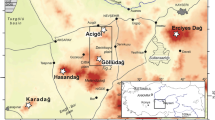Abstract
The Bag Tephra is a widespread tephra layer interbedded in Quaternary loess deposits along the Danubian valley of Hungary and Slovakia. Its age is poorly defined between 788 and 380 ka B.P. The glass and mineral composition – micropumice clasts of phono-tephrite and blocky shards of tephri-phonolite associated with two kinds of clinopyroxene, fassaitic diopside, and salite – is very distinctive. This tephra could be used as a chronological marker, as soon as its age is refined. The probable origin is the middle Italian volcanic area.
Similar content being viewed by others
Author information
Authors and Affiliations
Additional information
Received: 3 November 1998 / Accepted: 18 January 1999
Rights and permissions
About this article
Cite this article
Pouclet, A., Horvath, E., Gabris, G. et al. The Bag Tephra, a widespread tephrochronological marker in Middle Europe: chemical and mineralogical investigations. Bull Volcanol 61, 265–272 (1999). https://doi.org/10.1007/s004450050275
Issue Date:
DOI: https://doi.org/10.1007/s004450050275




